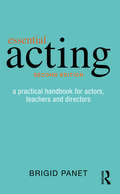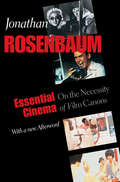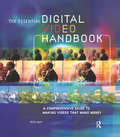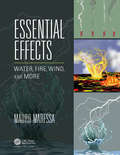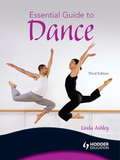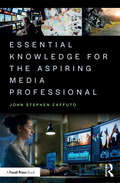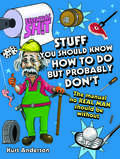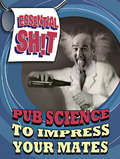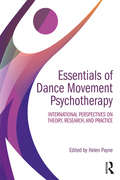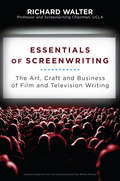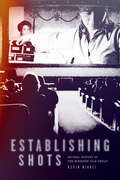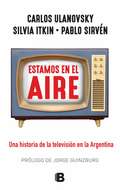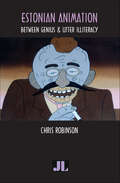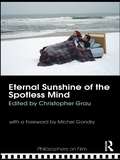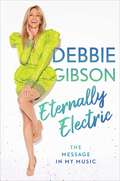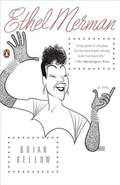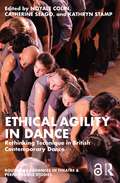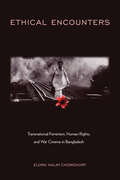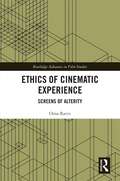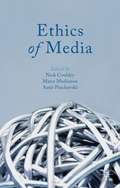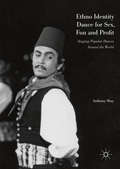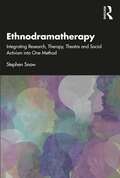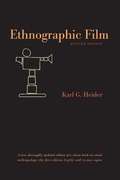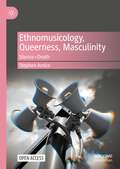- Table View
- List View
Essential Acting: A Practical Handbook for Actors, Teachers and Directors
by Brigid PanetHow do actors fuse thought, emotion and action within their creative process? Essential Acting is an inspired and reliable toolbox for actors and teachers in the classroom, the rehearsal room and the workshop. RADA’s Brigid Panet has distilled nearly 60 years of acting, directing and actor training into a unique recipe which brilliantly combines the teachings of Stanislavsky and Laban into an invaluable practical resource. These exercises are built around the need for simple, achievable techniques that can be applied by actors, teachers and directors to answer the myriad requirements of actor training. The goal is to produce a continuous level of achievement, addressing: • How to rehearse • How to work with a text • How to audition for drama school • How to access the truth of feelings and actions Essential Acting will be a must-have purchase for anyone looking for a comprehensive study guide to the necessary work of the actor.
Essential Cinema: On the Necessity of Film Canons
by Jonathan RosenbaumIn his astute and deeply informed film reviews and essays, Jonathan Rosenbaum regularly provides new and brilliant insights into the cinema as art, entertainment, and commerce. Guided by a personal canon of great films, Rosenbaum sees, in the ongoing hostility toward the idea of a canon shared by many within the field of film studies, a missed opportunity both to shape the discussion about cinema and to help inform and guide casual and serious filmgoers alike.In Essential Cinema, Rosenbaum forcefully argues that canons of great films are more necessary than ever, given that film culture today is dominated by advertising executives, sixty-second film reviewers, and other players in the Hollywood publicity machine who champion mediocre films at the expense of genuinely imaginative and challenging works. He proposes specific definitions of excellence in film art through the creation a personal canon of both well-known and obscure movies from around the world and suggests ways in which other canons might be similarly constructed.Essential Cinema offers in-depth assessments of an astonishing range of films: established classics such as Rear Window, M, and Greed; ambitious but flawed works like The Thin Red Line and Breaking the Waves; eccentric masterpieces from around the world, including Irma Vep and Archangel; and recent films that have bitterly divided critics and viewers, among them Eyes Wide Shut and A.I. He also explores the careers of such diverse filmmakers as Robert Altman, Raúl Ruiz, Frank Tashlin, Elaine May, Sam Fuller, Terrence Davies, Edward Yang, Hou Hsiao-hsien, and Orson Welles. In conclusion, Rosenbaum offers his own film canon of 1,000 key works from the beginning of cinema to the present day. A cogent and provocative argument about the art of film, Essential Cinema is also a fiercely independent reference book of must-see movies for film lovers everywhere.
Essential Digital Video Handbook: A Comprehensive Guide to Making Videos That Make Money
by Pete MayThe digital video revolution has blurred the lines between professional and amateur equipment, with some Hollywood movies being shot and edited using the same technology that families use for their vacation footage. With sales of digital video cameras and computer-based editing systems skyrocketing, more and more people are seeing the potential and are anxious to advance their own personal video production skills to a higher level. The Essential Digital Video Handbook will help you, the beginner and budding professional become a better writer, producer, director, photographer, and editor. Author Pete May's sound advice and no-nonsense approach will help you achieve results that will wow audiences whether they're gathered in the family room or the corporate boardroom.The Essential Digital Video Handbook takes the you through every step of the process, from buying the right equipment to editing footage. This book shares tips on achieving professional quality results by understanding and exploiting visual language, both by initially following the rules and then by breaking them with style and confidence. Videographers will also learn to sound like professionals by understanding and speaking the language of the business.Instead of narrowly focusing on just the latest equipment and technology, May uses lessons he learned during twenty-five years in the television business to drill down to the most important stuff: the principles that don't change, and the tricks behind making videos that document, entertain, train, motivate, persuade, satisfy, and even have the ability to make money.
Essential Effects: Water, Fire, Wind, and More
by Mauro MaressaAnimate the world around you! Follow along with veteran Disney effects artist Mauro Maressa as he teaches you how to create and animate natural phenomena like water, fire, smoke, lightning, lava, mud, and wind. Essential Effects will help you plan, draw, design, and animate traditional 2D effects, taking your ideas all the way from rough sketch to finished product. Using a series of full-color visual breakdowns and diagrams, this book gives you a clear, concise understanding of what it takes to create credible, compelling effects in your own projects. Key Features Build a strong foundation of observation and drawing skills that you can rely on for the rest of your career Tips and tricks for applying classic effects principles to computer-animated and CG projects Over 400 full-color images and diagrams for clear step-by-step learning
Essential Guide to Dance, 3rd edition
by Linda AshleyThis third edition of the bestselling text ESSENTIAL GUIDE TO DANCE is thoroughly updated to meet the new AS/A2 specifications and relevant Applied A-levels, BTEC and other Dance qualifications. Now in full colour, highly illustrated, and packed with tasks and activities to cover all aspects of current courses, this text will appeal to both teachers and students.Students are brought right up to date with clear explanations of choreography, performance and appreciation of Dance, as well as recent examples of new set works and choreographers. With further video and photo interactive analysis tasks, the addition of short revision tests and updated professional examples alongside many contemporary photographs, ESSENTIAL GUIDE TO DANCE Third Edition provides students with comprehensive support and guidance.With its emphasis on the practical aspects of Dance and its interactive features that encourage effective learning, ESSENTIAL GUIDE TO DANCE Third Edition will be essential for all students of Dance and their teachers.Linda Ashley has extensive experience as a writer, choreographer, performer and teacher of Dance. Linda is currently Dance Research Leader at AUT University, New Zealand, Linda has written several Dance titles, published in the UK and New Zealand, including the two previous bestselling editions of ESSENTIAL GUIDE TO DANCE, both published by Hodder.
Essential Knowledge for the Aspiring Media Professional
by John Stephen ZaffutoEssential Knowledge for the Aspiring Media Professional provides readers with the skillset needed to produce professional, high-quality video content in today’s competitive media landscape. The author draws on over two decades of industry experience to offer strategies for how to develop a sense of design, adopt a holistic approach to the media production process, and craft a distinct idea for a project’s intent and form. In five in-depth chapters, the book delves into topics ranging from pre-production and planning processes to technical considerations and post-production methods. It concludes with an overview of career opportunities for aspiring media-makers. This book is an invaluable resource for students and professionals alike looking to hone creative production techniques within a broad range of formats and environments, particularly those requiring effective marketing and advertising-oriented content.
Essential Shit - Stuff You Should Know How to Do, but Probably Don't (Essential Shit)
by Kurt AndersonBlokes don't know everything but fortunately this invaluable guide features every manly activity a real guy should be able to do. So sit back, crack open a cold one and let your education commence. From changing a flat tyre to chopping down a tree, operating a drill convincingly and even downing a shot without making a face...this manual has it all! This little gem is packed with hidden secrets and clever solutions. So read, learn and live it. You'll never have to ask for directions again.
Essential Shit: Pub Science to Impress Your Mates (Essential Shit)
by Randall PefferThis is science but not as you know it - here you get all the really cool stuff they didn't teach you in the classroom but you've always wanted to know...For example, ever wondered why hair grows out your nose and ears and if cockroaches really would survive a nuclear blast? Do you wish you could crush a beer can on your forehead or open a door with a credit card? Then look no further, all will be explained here. This is the ultimate science textbook and will answer all your craziest science questions with clarity, practical guidance and, of course, mirth. This is the perfect source of pub ammo.
Essentials of Dance Movement Psychotherapy: International Perspectives on Theory, Research, and Practice
by Helen PayneEssentials of Dance Movement Psychotherapy contributes to the global interest in embodiment approaches to psychotherapy and to the field of dance movement psychotherapy specifically. It includes recent research, innovative theories and case studies of practice providing an inclusive overview of this ever growing field. As well as original UK contributions, offerings from other nations are incorporated, making it more accessible to the dance movement psychotherapy community of practice worldwide. Helen Payne brings together well-known, experienced global experts along with rising stars from the field to offer the reader a valuable insight into the theory, research and practice of dance movement psychotherapy. The contributions reflect the breadth of developing approaches, covering subjects including: • combining dance movement psychotherapy with music therapy; • trauma and dance movement psychotherapy; • the neuroscience of dance movement psychotherapy; • the use of touch in dance movement psychotherapy; • dance movement psychotherapy and autism; • relational dance movement psychotherapy. Essentials of Dance Movement Psychotherapy will be a treasured source for anyone wishing to learn more about the psychotherapeutic use of creative movement and dance. It will be of great value to students and practitioners in the arts therapies, psychotherapy, counselling and other health and social care professions.
Essentials of Screenwriting
by Richard WalterHollywood's premier teacher of screenwriting shares the secrets of writing and selling successful screenplays Anyone fortunate enough to win a seat in Professor Richard Walter's legendary class at UCLA film school can be confident their career has just taken a quantum leap forward. His students have written more than ten projects for Steven Spielberg alone, plus hundreds of other Hollywood blockbusters and prestigious indie productions, including two recent Oscar winners for best original screenplay-Milk (2008) and Sideways (2006). In this updated edition, Walter integrates his highly coveted lessons and principles from Screenwriting with material from his companion text, The Whole Picture, and includes new advice on how to turn a raw idea into a great movie or TV script-and sell it. There is never a shortage of aspiring screenwriters, and this book is their bible.
Establishing Shots: An Oral History of the Winnipeg Film Group
by Kevin NikkelA behind-the-scenes account of a cultural institution that made a distinctive mark on Canadian film Establishing Shots captures a diverse group of filmmakers in an immersive oral history of one of the most important and notorious artist-run centres in Canada: the Winnipeg Film Group. Both a deep dive into the life of an internationally renowned institution and an exploration of the growth of an experimental film movement, this richly illustrated collection of interviews produces a vibrant picture of the Winnipeg Film Group’s origins, successes, failures, and ongoing impact. Formed in 1974 as a membership-based film production, training, and exhibition cooperative, the Winnipeg Film Group was part of a wave of artist-run centres funded by the Canada Council for the Arts. Kevin Nikkel’s candid conversations with twenty-nine administrators and filmmakers— including Guy Maddin, Shawna Dempsey, and Matthew Rankin—reveal the precarious path of independent artists, struggles for equality within the industry, and the importance of place in their work. An engaging resource for scholars and historians of Manitoban and Canadian culture and film, Establishing Shots also shows emerging filmmakers how other artists got their start and learned their craft.
Estamos en el aire: Una historia de la television en la Argentina
by Carlos Ulanovsky Pablo Sirvén Silvia Itkin<P>En 17 de octubre de 1951, tres cámaras apuntaron desde el Banco Nación hacia los balcones de la Casa Rosada para registrar la nada casual coincidencia entre el nacimiento ese día de la televisión argentina y el masivo acto con el que el peronismo celebraba su cumpleaños N° 6 en la Plaza de Mayo. Fue el último al que asistió Evita, ya entonces gravemente enferma, y artífice de la llegada de ese nuevo medio que encargó desarrollar a su antiguo empleador y mentor artístico en Radio Belgrano, don Jaime Yankelevich. Sesenta y cinco años más tarde, y a diecisiete de su primera edición, Estamos en el aire. Una historia de la televisión en la Argentina, sigue siendo el libro que mejor registra el recorrido del más popular de los medios de comunicación a lo largo del febril siglo XX. <P> Enorme tarea de rescate de cientos de personajes, programas, acontecimientos políticos y culturales que quedaron grabados para siempre en el recuerdo de varias generaciones. Los grandes éxitos y los grandes fracasos, las anécdotas más divertidas, los ratings récords, las biografías que no pueden faltar; todo está en Estamos en el aire, la enciclopedia más completa sobre la TV argentina contada por tres expertos/testigos/televidentes de esa epopeya audiovisual. <P>Carlos Ulanovsky narra en la sección “Fundación, estilos y costumbres” el período pionero, entre aquel octubre del 51 y 1966. Silvia Itkin desarrolla dos épocas cruciales: la más dorada, desde el inicio de 1967, hasta la más sombría a fines de 1982, bajo el título “Años de oro. Años de barro”. Pablo Sirvén relata en “Del fin de la inocencia a la globalización” la etapa que va desde el luminoso 1983 hasta el más desencantado 1998, que ya preanunciaba la hecatombe socioeconómica del nuevo siglo/milenio que despuntaba. <P>En esta nueva edición, se agregan tres epílogos de cada autor para revisar qué ha sido de esos años historiados en relación al presente. Textos que iluminan respecto del tipo de televidentes en que nos hemos convertido en la compleja era de las redes sociales y de las variadas y complicadas, pero también estimulantes realidades reales y virtuales que nos atraviesan como sociedad.
Estonian Animation: Between Genius & Utter Illiteracy
by Chris RobinsonEver wonder why Estonian animation features so many carrots or why cows often perform pyramids? Well, neither question is answered in Chris Robinson's new book, Estonian Animation. Robinson's frank, humorous, and thoroughly researched book traces the history of Estonia's acclaimed animation scene from early experiments in the 1930s to the creation of puppet (Nukufilm) and cel (Joonisfilm) animation studios during the Soviet era, as well as Estonia's surprising international success during the post-Soviet era. In addition, Robinson writes about the discovery of films by four 1960s animation pioneers who, until the release of this book, had been unknown to most Estonian and international animation historians.
Eternal Sunshine of the Spotless Mind (Philosophers on Film)
by Christopher GrauEternal Sunshine of the Spotless Mind is one of the most widely discussed and thought-provoking films of recent years. This is the first book to explore and address the philosophical aspects of Eternal Sunshine of the Spotless Mind. Beginning with a helpful introduction that places each essay in context, specially commissioned chapters examine the following topics: philosophical issues surrounding love, friendship, affirmation and repetition the role of memory (and the emotions) in personal identity and decision-making the morality of imagination and ethical importance of memory philosophical questions about self-knowledge and knowing the minds of others the aesthetics of the film considered in relation to Gondry’s other works and issues in the philosophy of perception Including a foreword by Michel Gondry and a list of further reading, this volume is essential reading for students interested in philosophy and film studies.
Eternally Electric: The Message in My Music
by Debbie GibsonIn her long-awaited debut, Debbie Gibson reflects on the lessons she learned in her years as a young pop pioneer and on her hard-earned journey to embrace her authentic self, allowing her to lead the healthy, engaged—and electric!—life she does today. Debbie Gibson was just sixteen when she released her multi-platinum debut album Out of the Blue and recorded &“Foolish Beat&” in 1988, making her the youngest person to ever write, produce, and perform a Billboard Hot 100 chart-topper. A child actress who became the original pop princess, Debbie had full creative control over her music and, when that no longer aligned with a transitioning arts scene, she went on to star in Broadway&’s Les Misérables, Beauty and the Beast, and Cabaret, as well as in the London production of Grease. Yet, for all the accolades and achievements, her success came at a high price. Anxiety, depression, financial struggles, illness—Debbie writes candidly about these and other challenges, and how she ultimately redesigned her life to overcome them. This is the story of her not only surviving, but thriving: returning to her musical roots, releasing new albums, going back out on tour, and living the best version of her authentic self to remain…Eternally Electric!
Ethel Merman
by Brian KellowMore than twenty years after her death, Ethel Merman continues to set the standard for American musical theater. The stories about the supremely talented, famously strong-willed, fearsomely blunt, and terrifyingly exacting woman are stuff of legend. But who was Ethel Agnes Zimmermann, really? Brian Kellow's definitive biography of the great Merman is superb, and the first account to examine both the artist and the woman with as much critical rigor as empathy. Through dozens of interviews with her colleagues, friends, and family members, Kellow traces the arc of her life and her thirty-year singing career to reveal many surprising facts about Broadway's biggest star.
Ethical Agility in Dance: Rethinking Technique in British Contemporary Dance (Routledge Advances in Theatre & Performance Studies)
by Noyale Colin Catherine Seago Kathryn StampThis edited collection examines the potential of dance training for developing socially engaged individuals capable of forging ethical human relations for an ever-changing world and in turn frames dance as a fundamental part of human experience. This volume draws together a range of critical voices to reflect the inclusive potential of dance. The contributions offer perspectives on contemporary dance training in Britain from dance educators, scholars, practitioners and artists. Through examining the politics, values and ethics of learning dance today, this book argues for the need of a re-assessment of the evolving practices in dance training and techniques. Key questions address how the concept of ‘technique’ and associated systems of training in dance could be redefined to enable the collaboration of skills and application of ideas necessary to twenty-first-century dance. The editors present these ideas in different modes of writing. This collection of essays, conversations and manifestos offers a way to explore, debate and grasp the shifting values of contemporary dance. Examining these values in the applied field of dance reveals a complex and contrasting range of ideas, encompassing broad themes including the relationships between individuality and collectivity, rigour and creativity, and virtuosity and inclusivity. This volume points to ethical techniques as providing a way of navigating these contrasting values in dance. It serves as an invaluable resource for academics as well as practitioners and students.
Ethical Encounters: Transnational Feminism, Human Rights, and War Cinema in Bangladesh
by Elora Halim ChowdhuryEthical Encounters is an exploration of the intersection of feminism, human rights, and memory to illuminate how visual practices of recollecting violent legacies in Bangladeshi cinema can conjure a global cinematic imagination for the advancement of humanity. By examining contemporary, women-centered Muktijuddho cinema—features and documentaries that focus on the Bangladesh Liberation War of 1971—Elora Chowdhury shows how these films imagine, disrupt, and reinscribe a gendered nationalist landscape of trauma, freedom, and agency. Chowdhury analyzes Bangladeshi feminist films including Meherjaan, and Itihaash Konna (Daughters of History), as well as socially-engaged films by activist-filmmakers including Jonmo Shathi (Born Together), and Shadhinota (A Certain Liberation), to show how war films of Bangladesh can generate possibilities for gender justice. Chowdhury argues that justice-driven films are critical to understanding and negotiating the layered meanings and consequences of catastrophic human suffering yet at the same time they hint at subjectivities and identities that are not reducible to the politics of suffering. Rather, they are key to creating an alternative and disruptive archive of feminist knowledge—a sensitive witnessing, responsible spectatorship, and just responsibility across time, and space. Drawing on Black and transnational feminist critiques, Chowdhury explores questions around women’s place, social roles, and modes of participation in war as well as the visual language through which they become legible as victims/subjects of violence and agents of the nation. Ethical Encounters illuminates the possibilities of film as a site to articulate an ethics that acknowledges a founding violence of the birth of a nation, recuperates it even if in fragments, and imagines differently the irreconcilable relationship between humanity, liberty, and justice.
Ethical Encounters: Transnational Feminism, Human Rights, and War Cinema in Bangladesh
by Elora Halim ChowdhuryEthical Encounters is an exploration of the intersection of feminism, human rights, and memory to illuminate how visual practices of recollecting violent legacies in Bangladeshi cinema can conjure a global cinematic imagination for the advancement of humanity. By examining contemporary, women-centered Muktijuddho cinema—features and documentaries that focus on the Bangladesh Liberation War of 1971—Elora Chowdhury shows how these films imagine, disrupt, and reinscribe a gendered nationalist landscape of trauma, freedom, and agency. Chowdhury analyzes Bangladeshi feminist films including Meherjaan, and Itihaash Konna (Daughters of History), as well as socially-engaged films by activist-filmmakers including Jonmo Shathi (Born Together), and Shadhinota (A Certain Liberation), to show how war films of Bangladesh can generate possibilities for gender justice. Chowdhury argues that justice-driven films are critical to understanding and negotiating the layered meanings and consequences of catastrophic human suffering yet at the same time they hint at subjectivities and identities that are not reducible to the politics of suffering. Rather, they are key to creating an alternative and disruptive archive of feminist knowledge—a sensitive witnessing, responsible spectatorship, and just responsibility across time, and space. Drawing on Black and transnational feminist critiques, Chowdhury explores questions around women’s place, social roles, and modes of participation in war as well as the visual language through which they become legible as victims/subjects of violence and agents of the nation. Ethical Encounters illuminates the possibilities of film as a site to articulate an ethics that acknowledges a founding violence of the birth of a nation, recuperates it even if in fragments, and imagines differently the irreconcilable relationship between humanity, liberty, and justice.
Ethics of Cinematic Experience: Screens of Alterity (Routledge Advances in Film Studies)
by Orna RavivEthics of Cinematic Experience: Screens of Alterity deals with the relationship between cinema and ethics from a philosophical perspective, finding an intrinsic connection between film spectatorship and the possibility of being open to different modes of alterity. The book’s main thesis is that openness to otherness is already found in the basic structures of cinematic experience. Through a close examination of the ethical relevance of the philosophy of Maurice Merleau-Ponty, Stanley Cavell, Emmanuel Levinas and Gilles Deleuze to cinema studies, Ethics of Cinematic Experience: Screens of Alterity pursues the question of how film can open the viewer to what is not her, and so bring her to encounter otherness in a way that is unique to cinematic experience. The book sees ethics as not just the subject, content or story of a film but part of its aesthetic structure. Accompanied by readings of films mainly from mainstream cinema, each chapter focuses on a different aspect of the encounter with alterity through cinema. The book gives particular attention to how theoretical discussion of the cinematic close-up can lead to ethical insights into the status of both the human and the non-human in film, and thus lead to an understanding of the relationships the viewer makes with them. The book is a helpful resource for students and scholars interested in the relationship between philosophy, film and ethics, and is appropriate for students of philosophy and media and cultural studies.
Ethics of Media
by Nick Couldry Mirca Madianou Amit PinchevskiEthics of Media reopens the question of media ethics. Taking an exploratory rather than prescriptive approach, an esteemed collection of contributors tackle the diverse areas of moral questioning at work within various broadcasting practices, accommodating the plurality and complexity of present-day ethical challenges posed by the world of media.
Ethno Identity Dance for Sex, Fun and Profit
by Anthony ShayPeople all over the world dance traditional and popular dances that havebeen staged for purposes of representing specific national and ethnic groups. Anthony Shay suggests these staged dance productions be called "ethno identitydances", especially to replace the term "folk dance," which Shay suggestsshould refer to the traditional dances found in village settings as an organicpart of village and tribal life. Shay investigates the many motives that impelpeople to dance in these staged productions: dancing for sex or dancing sexydances, dancing for fun and recreation, dancing for profit - such as dancingfor tourists - dancing for the nation or to demonstrate ethnic pride. In thisstudy Shay also examines belly dance, Zorba Dancing in Greek nightclubs andrestaurants, Tango, Hula, Irish step dancing, and Ukrainian dancing.
Ethnodramatherapy: Integrating Research, Therapy, Theatre and Social Activism into One Method
by Stephen SnowEthnodramatherapy explores the integration of the performance ethnography method, known as ethnodrama, with the principles and practices of drama therapy to establish a sound theoretical formulation for ethnodramatherapy, and considers its use as art, as therapy, as research and as a vehicle for social justice. The book begins by defining ethnodramatherapy – an original synthesis created by the author through deep study and practice of Mienczakowski’s enthnodrama, combined with 35 years of his own practice and research in drama therapy, creative arts therapies and therapeutic theatre. The book describes the origins of ethnodramatherapy, along with its evolution and method. It then delves into applications of the practice highlighted by five case studies with different audiences in different settings. Subjects include adults with developmental disabilities, female adolescents in youth protection, caregivers for loved ones with mental illnesses and Chinese students exploring controversial issues of oppression in China. Complex ethical issues are reviewed and suggestions are made on how to deal with some of the challenging ethical situations that are likely to arise in the ethnodramatherapy process. What emerges is a powerful tool that harnesses theatrical art, ethnographic research and the clinical techniques of drama therapy to create a potential for emancipatory experience for both performers and audiences. This exciting and dynamic synthesis of drama therapy, performance ethnography, theatrical art and social activism will be of interest to the whole community of theatre practitioners and scholars who use theatre to effect individual and social change, including the disciplines of applied theatre, theatre education, experimental theatre, performance studies, and, of course, drama therapy, psychodrama and the other creative arts therapies.
Ethnographic Film
by Karl G. HeiderFrom reviews of the first edition:"Ethnographic Film can rightly be considered a film primer for anthropologists. "-Choice"This is an interesting and useful book about what it means to be ethnographic and how this might affect ethnographic filmmaking for the better. It obviously belongs in all departments of anthropology, and most ethnographic filmmakers will want to read it. "-EthnohistoryEven before Robert Flaherty released Nanook of the North in 1922, anthropologists were producing films about the lifeways of native peoples for a public audience, as well as for research and teaching. Ethnographic Film (1976) was one of the first books to provide a comprehensive introduction to this field of visual anthropology, and it quickly became the standard reference. In this new edition, Karl G. Heider thoroughly updates Ethnographic Film to reflect developments in the field over the three decades since its publication, focusing on the work of four seminal filmmakers-Jean Rouch, John Marshall, Robert Gardner, and Timothy Asch. He begins with an introduction to ethnographic film and a history of the medium. He then considers many attributes of ethnographic film, including the crucial need to present "whole acts," "whole bodies," "whole interactions," and "whole people" to preserve the integrity of the cultural context. Heider also discusses numerous aspects of making ethnographic films, from ethics and finances to technical considerations such as film versus video and preserving the filmed record. He concludes with a look at using ethnographic film in teaching.
Ethnomusicology, Queerness, Masculinity: Silence=Death
by Stephen AmicoThis open access book explores the disciplinary, disciplined, and recent interdisciplinary sites and productions of ethnomusicology and queerness, arguing that both academic realms are founded upon a destructive masculinity—indissolubly linked to coloniality and epistemic hegemony—and marked by a monologic, ethnocentric silencing of embodied, same-sex desire. Ethnomusicology’s fetishization of masculinizing fieldwork; queerness’s functioning as Anglophone master category; and both domains’ devaluation of sensuality and experience, concomitant with an adherence to provincial, Western conceptions of knowledge production, are revealed as precluding the possibilities for equitable, dialogic pluriversality. Enlisting the sonic as theoretical intervention, the disciplined/disciplining ethno and queer are reimagined in relation to negative emotions and intractable affect, ultimately vanquished, and replaced by explorations of sound, sex/uality, and experiential somaticity within a protean, postdisciplinary space of material/epistemic equity. This uncompromising, long-overdue critique will be of interest to researchers and students from numerous theoretical backgrounds, including music, sound, gender, queer, and postcolonial/decolonial studies.
